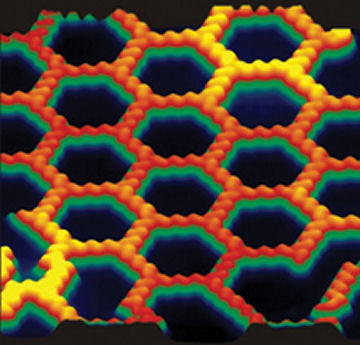This surprising honeycomb pattern emerged after an organic-chemical vapor settled onto a cold copper surface, which was then heated and cooled. On copper (black), each anthraquinone molecule appears in this scanning tunneling microscope image as a mound that’s orange or yellow on top, green in the middle, and blue at the base.

Scientists had never seen spontaneous molecular patterns include voids that were so much bigger than the molecules themselves, says Ludwig Bartels of the University of California, Riverside. The pattern results from a balance of attractive and repulsive forces, his team proposes in the Aug. 18 Science. Typically, making such open patterns requires elaborately crafted templates. Bartels suggests that by merely tweaking properties of molecules or surfaces, researchers might generate various patterns and pore sizes.






